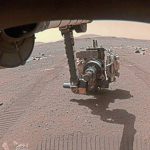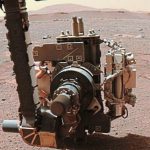When Sanford Asher interviewed to join the University of Pittsburgh chemistry faculty in 1979, he gave a presentation on a piece of research he planned to conduct if hired.
Asher was working on something called ultraviolet Raman spectroscopy, which uses UV light to excite molecules as a way to determine the basic components of a piece of matter.
Today, that technology is helping feed Asher a steady stream of information from about 200 million miles away — as one of the many tools attached to NASA’s Perseverance rover, which landed Feb. 18 on the Red Planet.
“We’re looking for life,” said Asher. “We’re looking at chemical structure from a distance.”
That required the development of a laser that could not only survive the trip, but also the landing and the Martian atmosphere without any damage to the extreme calibration required to function properly.
“It’s challenging to build a laser that will work on an optical table in a lab, just from day to day, and that’s in the best conditions possible,” Asher said. “It seems almost impossible that you could do the same thing on a different planet, developing enough structural integrity that it will stay aligned as such a delicate piece of equipment.”
In addition, temperatures on Mars can fluctuate from roughly room temperature to the freezing negative temperature of liquid nitrogen (-320 F).
California-based Photon Systems developed the type of laser that could function in such an environment. Along with Asher and others, they’ve undertaken the Scanning Habitable Environments with Raman and Luminescence for Organics and Chemicals project, nicknamed SHERLOC.
Asher was the first person to buy one of Photon’s lasers, back in 1997, according to Photon CEO William Hug.
“NASA followed suit the next year, and we’ve worked ever since with NASA’s Jet Propulsion Laboratory building custom instruments for expeditions to Antarctica, the Arctic and the deep ocean in both the Atlantic and Pacific,” Hug said.
The SHERLOC laser lights up matter, and it determines what kind of minerals and chemicals it contains, Asher said.
“Mars has had a rougher time than the Earth,” he said. “Mars doesn’t have a magnetic field, and there’s a lot of charged particles from the sun that have baked it pretty well. So, the story has to be different for Mars than for Earth.”
So what are Asher and the SHERLOC team looking for?
The simplest answer would seem to be water, among the primary building blocks of life here on Earth.
But Asher said more important than water itself is the fact that the substance created by combining two parts hydrogen and one part oxygen has a liquid phase among its properties.
“The liquid phase is very important to chemistry, and life needs to be able to do chemistry,” Asher said. “One guess is that there is some liquid-based form of living chemistry, and we should perhaps be looking around areas that are chemically liquefied.”
And while there may not be any water on Mars at present, SHERLOC also is trying to determine if it has been there in the past.
“That’s why the people involved in this program chose the landing site they did,” Asher said. “It looked like it may at one time have been the channel of a river, or a delta, and there may be sediment that contains fossil-like things.”
Hug said the search wouldn’t be possible without Asher’s work.
“Perseverance has been a grand adventure,” Hug said. “But professor Asher is the grandfather of all of this, the luminary who started and pushed all of the benefits of detection of a wide range of materials using deep UV Raman spectroscopy.”
The SHERLOC and the myriad other tools aboard the rover will continue to gather and return data for what Asher hopes will be many years.
“Researchers have a pretty good idea of how life works and how molecules are used on Earth,” Asher said. “But it’s pretty clear that life would have evolved differently on Mars. We’ll see. That’s why we went there and why we’re asking these questions.
“We’re hoping for surprises.”













